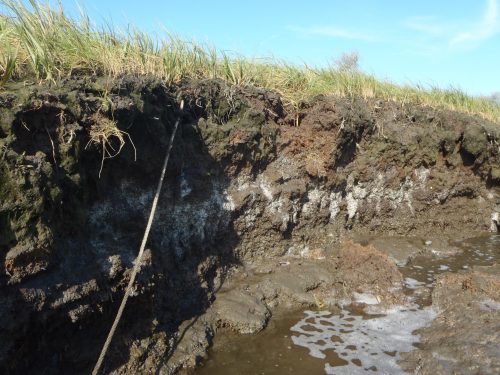Due to human activity, carbon dioxide levels in the atmosphere continue to rise, contributing to increased global temperatures, rising sea levels, and other devastating environmental consequences. Salt marshes, widely found in coastal regions, are known to reduce CO2 levels by trapping carbon within the soil, reducing the impact of climate change. Yet, how exactly these natural systems respond to human stresses and the underlying mechanisms controlling carbon storage capacity are yet to be fully understood. Recent research conducted at Northeastern University provides some clues towards answering these questions.
Compared to dry-land systems, salt marshes are vastly more efficient at storing carbon in the form of organic matter. Because marshes are waterlogged, there is very little oxygen in the soil. “Decomposition, which requires oxygen, is much, much slower in these saturated soils… so salt marshes are able to accumulate more organic matter because it doesn’t decompose as quickly,” said Jennifer Bowen, professor of marine and environmental sciences at Northeastern.
Bowen and her team of researchers studied how nitrogen enrichment from pollution affects the ability of salt marshes to store carbon. Although prior research exists, scientists are still unsure how nitrogen loading ultimately affects carbon storage capacity. Nitrogen has been found to increase carbon capacity by converting carbon into biomass, but it has also been found to decrease carbon capacity by stimulating organic decomposition.
To understand how carbon is stored in salt marshes, Bowen’s team turned to microbes, which do most of the filtering of pollutants and fix carbon dioxide through photosynthesis. Like all living things, microbes require energy in order to survive. Sulfate—which is available in virtually unlimited supply from seawater—is most commonly used by salt marsh microbes to fuel essential chemical processes. However, sulfate does not provide as much energy to metabolize complex organic matter as do oxygen and nitrate—a form of nitrogen. As a result, microbes using sulfate are only able to decompose simple organic matter. Over time, as sediment is deposited, the remaining complex organic matter becomes buried deep within the soil. “The question was: given an unlimited supply of [nitrogen], what is going to happen to the organic matter and to the bacterial community?” Bowen said.
Bowen’s team collected sediment samples from a salt marsh complex in Plum Island Sound, Massachusetts. Back at the lab, the team compared decomposition rates between two groups: sediments supplied with normal seawater and sediments supplied with nitrate-enriched seawater. They also compared the decomposition rates of sediments collected from different depths. Decomposition was assessed by measuring the levels of microbial respiration, including CO2, over a span of roughly ninety days.
Bowen’s key finding was that nitrate addition significantly increased organic matter decomposition, even at depths normally resistant to decomposition. Whereas sulfate was consumed by microbes only in shallow sediments, nitrate was utilized in both shallow and deep sediments. These results suggest the existence of buried organic matter pools only accessible to the microbes when nitrate is present. Without a supply of nitrate, organic matter deep within the sediment remains trapped. Nitrogen loading decreases overall burial of organic matter, thus reducing carbon storage.
The research team also found that the presence of nitrate alters the microbe community composition. Microbe species that are better suited for using nitrate as its energy source became more abundant. In addition, microbe diversity decreased, as microbes that could take advantage of the higher nitrate levels outcompeted others.
Bowen’s work could have important implications on the long-term carbon storage ability of salt marshes. According to Bowen, further research is being conducted in order to better understand nitrate’s effect on salt marsh systems outside of the lab environment. The interplay between microbes and plants poses an interesting question for future study, as does the effects of other forms of nitrogen, such as ammonium, on carbon storage capacity. “To apply it to an entire marsh system requires a couple of other research steps,” Bowen said.
But Bowen noted that nitrogen contamination is not the only major threat to salt marshes. “The biggest one, probably, is sea level rise,” she said. Over time, salt marshes have adapted to changes in sea level. However, current shoreline building prevents salt marshes from migrating inland. “If the rate of sea level rise is too fast, it is unclear whether salt marshes are going to be able to keep pace,” Bowen said. Bowen also cited habitat destruction as a major threat, especially in areas of minimal regulation outside the U.S.. Although this data is concerning, we can be confident that Bowen’s team will keep searching for answers and protect salt marshes for years to come.

